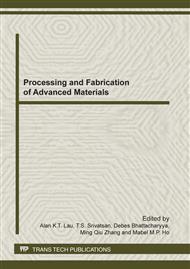p.156
p.160
p.164
p.168
p.175
p.187
p.191
p.196
p.206
The Influence of Processing on Microstructural Development, Tensile Response and Fracture Behavior of Aluminum Alloy 5083
Abstract:
In this paper, the specific influence of quasi-isostatic forging and rolling of cryomilled powder on microstructural development and resultant tensile deformation and fracture behavior of aluminum alloy 5083 is highlighted and comparison made with the coarse grained counterpart. The specific influence and contribution of strain hardening to enhancing strength of the ultra-fine grain microstructure of the aluminum alloy is presented and discussed. It is shown that the capability of the ultra fine grain microstructure to recover strength through the mechanism of work hardening is quite similar to the conventionally processed counterpart. The influence and role of intrinsic microstructural features in governing tensile deformation and fracture behavior is elaborated upon. The viable microscopic mechanisms governing final fracture behavior is discussed in light of the competing and mutually interactive influences of nature of loading, intrinsic microstructural effects, and deformation kinetics. Key Words: aluminum alloy 5083, processing, microstructure, tensile properties, fracture
Info:
Periodical:
Pages:
175-186
Citation:
Online since:
November 2011
Authors:
Keywords:
Price:
Сopyright:
© 2012 Trans Tech Publications Ltd. All Rights Reserved
Share:
Citation:


